Jiandong Li
Rethinking Regularization Methods for Knowledge Graph Completion
May 29, 2025



Abstract:Knowledge graph completion (KGC) has attracted considerable attention in recent years because it is critical to improving the quality of knowledge graphs. Researchers have continuously explored various models. However, most previous efforts have neglected to take advantage of regularization from a deeper perspective and therefore have not been used to their full potential. This paper rethinks the application of regularization methods in KGC. Through extensive empirical studies on various KGC models, we find that carefully designed regularization not only alleviates overfitting and reduces variance but also enables these models to break through the upper bounds of their original performance. Furthermore, we introduce a novel sparse-regularization method that embeds the concept of rank-based selective sparsity into the KGC regularizer. The core idea is to selectively penalize those components with significant features in the embedding vector, thus effectively ignoring many components that contribute little and may only represent noise. Various comparative experiments on multiple datasets and multiple models show that the SPR regularization method is better than other regularization methods and can enable the KGC model to further break through the performance margin.
Cooperative Tri-Point Model-Based Ground-to-Air Coverage Extension in Beyond 5G Networks
Jan 18, 2024Abstract:The utilization of existing terrestrial infrastructures to provide coverage for aerial users is a potentially low-cost solution. However, the already deployed terrestrial base stations (TBSs) result in weak ground-to-air (G2A) coverage due to the down-tilted antennas. Furthermore, achieving optimal coverage across the entire airspace through antenna adjustment is challenging due to the complex signal coverage requirements in three-dimensional space, especially in the vertical direction. In this paper, we propose a cooperative tri-point (CoTP) model-based method that utilizes cooperative beams to enhance the G2A coverage extension. To utilize existing TBSs for establishing effective cooperation, we prove that the cooperation among three TBSs can ensure G2A coverage with a minimum coverage overlap, and design the CoTP model to analyze the G2A coverage extension. Using the model, a cooperative coverage structure based on Delaunay triangulation is designed to divide triangular prism-shaped subspaces and corresponding TBS cooperation sets. To enable TBSs in the cooperation set to cover different height subspaces while maintaining ground coverage, we design a cooperative beam generation algorithm to maximize the coverage in the triangular prism-shaped airspace. The simulation results and field trials demonstrate that the proposed method can efficiently enhance the G2A coverage extension while guaranteeing ground coverage.
Energy-Efficient Power Control for Multiple-Task Split Inference in UAVs: A Tiny Learning-Based Approach
Dec 31, 2023Abstract:The limited energy and computing resources of unmanned aerial vehicles (UAVs) hinder the application of aerial artificial intelligence. The utilization of split inference in UAVs garners significant attention due to its effectiveness in mitigating computing and energy requirements. However, achieving energy-efficient split inference in UAVs remains complex considering of various crucial parameters such as energy level and delay constraints, especially involving multiple tasks. In this paper, we present a two-timescale approach for energy minimization in split inference, where discrete and continuous variables are segregated into two timescales to reduce the size of action space and computational complexity. This segregation enables the utilization of tiny reinforcement learning (TRL) for selecting discrete transmission modes for sequential tasks. Moreover, optimization programming (OP) is embedded between TRL's output and reward function to optimize the continuous transmit power. Specifically, we replace the optimization of transmit power with that of transmission time to decrease the computational complexity of OP since we reveal that energy consumption monotonically decreases with increasing transmission time. The replacement significantly reduces the feasible region and enables a fast solution according to the closed-form expression for optimal transmit power. Simulation results show that the proposed algorithm can achieve a higher probability of successful task completion with lower energy consumption.
Robust TOA-based Localization with Inaccurate Anchors for MANET
Dec 29, 2023Abstract:Accurate node localization is vital for mobile ad hoc networks (MANETs). Current methods like Time of Arrival (TOA) can estimate node positions using imprecise baseplates and achieve the Cram\'er-Rao lower bound (CRLB) accuracy. In multi-hop MANETs, some nodes lack direct links to base anchors, depending on neighbor nodes as dynamic anchors for chain localization. However, the dynamic nature of MANETs challenges TOA's robustness due to the availability and accuracy of base anchors, coupled with ranging errors. To address the issue of cascading positioning error divergence, we first derive the CRLB for any primary node in MANETs as a metric to tackle localization error in cascading scenarios. Second, we propose an advanced two-step TOA method based on CRLB which is able to approximate target node's CRLB with only local neighbor information. Finally, simulation results confirm the robustness of our algorithm, achieving CRLB-level accuracy for small ranging errors and maintaining precision for larger errors compared to existing TOA methods.
Coordinated Intra- and Inter-system Interference Management in Integrated Satellite Terrestrial Networks
Dec 13, 2023



Abstract:Leveraging the advantage of satellite and terrestrial networks, the integrated satellite terrestrial networks (ISTNs) can help to achieve seamless global access and eliminate the digital divide. However, the dense deployment and frequent handover of satellites aggravate intra- and inter-system interference, resulting in a decrease in downlink sum rate. To address this issue, we propose a coordinated intra- and inter-system interference management algorithm for ISTN. This algorithm coordinates multidimensional interference through a joint design of inter-satellite handover and resource allocation method. On the one hand, we take inter-system interference between low earth orbit (LEO) and geostationary orbit (GEO) satellites as a constraint, and reduce interference to GEO satellite ground stations (GEO-GS) while ensuring system capacity through inter-satellite handover. On the other hand, satellite and terrestrial resource allocation schemes are designed based on the matching idea, and channel gain and interference to other channels are considered during the matching process to coordinate co-channel interference. In order to avoid too many unnecessary handovers, we consider handover scenarios related to service capabilities and service time to determine the optimal handover target satellite. Numerical results show that the gap between the results on the system sum rate obtained by the proposed method and the upper bound is reduced as the user density increases, and the handover frequency can be significantly reduced.
Joint OAM Radar-Communication Systems: Target Recognition and Beam Optimization
May 11, 2022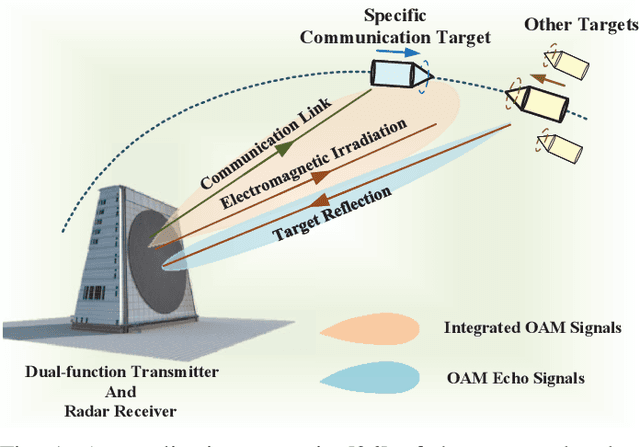
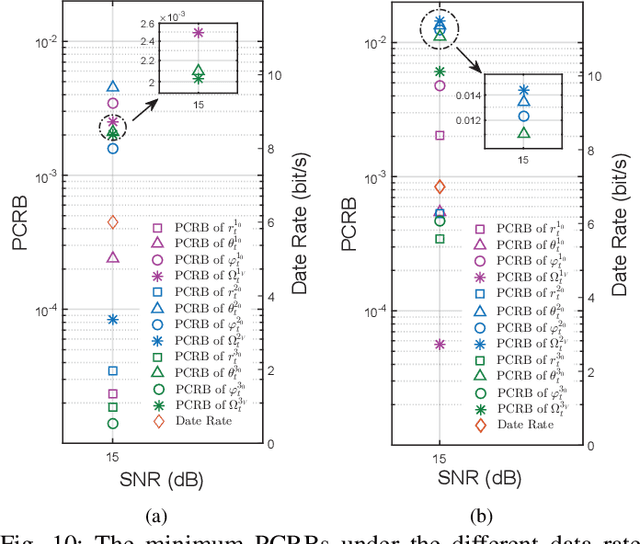

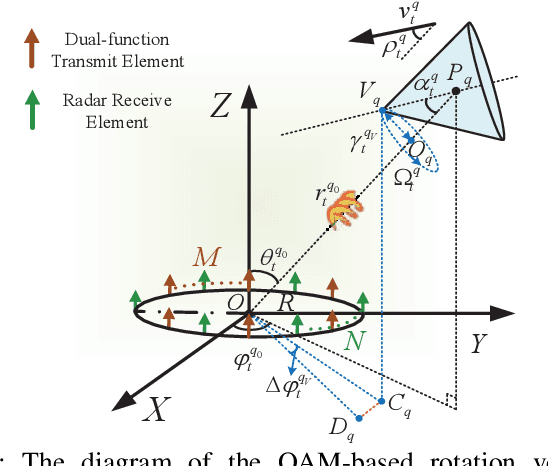
Abstract:Orbital angular momentum (OAM) radars are able to estimate the azimuth angle and the rotation velocity of multiple targets without relative motion or beam scanning. Moreover, OAM wireless communications can achieve high spectral efficiency (SE) by utilizing a set of information-bearing modes on the same frequency channel. Benefitting from the above advantages, in this paper, we design a novel radar-centric joint OAM radar-communication (RadCom) scheme based on uniform circular arrays (UCAs), which modulates information signals on the existing OAM radar waveform. In details, we first propose an OAM-based three-dimensional (3-D) super-resolution position estimation and rotation velocity detection method, which can accurately estimate the 3-D position and rotation velocity of multiple targets. Then, we derive the posterior Cramer-Rao bound (PCRB) of the OAM-based estimates and, finally, we analyze the transmission rate of the integrated communication system. To achieve the best trade-off between imaging and communication, the transmitted integrated OAM beams are optimized by means of an exhaustive search method. Both mathematical analysis and simulation results show that the proposed radar-centric joint OAM RadCom scheme can accurately estimate the 3-D position and rotation velocity of multiple targets while ensuring the transmission rate of the communication receiver, which can be regarded as an effective supplement to existing joint RadCom schemes.
Radio-Frequency Multi-Mode OAM Detection Based on UCA Samples Learning
Nov 29, 2021



Abstract:Orbital angular momentum (OAM) at radio-frequency provides a novel approach of multiplexing a set of orthogonal modes on the same frequency channel to achieve high spectral efficiencies. However, classical phase gradient-based OAM mode detection methods require perfect alignment of transmit and receive antennas, which greatly challenges the practical application of OAM communications. In this paper, we first show the effect of non-parallel misalignment on the OAM phase structure, and then propose the OAM mode detection method based on uniform circular array (UCA) samples learning for the more general alignment or non-parallel misalignment case. Specifically, we applied three classifiers: K-nearest neighbor (KNN), support vector machine (SVM), and back-propagation neural network (BPNN) to both single-mode and multi-mode OAM detection. The simulation results validate that the proposed learning-based OAM mode detection methods are robust to misalignment errors and especially BPNN classifier has the best generalization performance.
Joint Spatial Division and Coaxial Multiplexing for Downlink Multi-User OAM Wireless Backhaul
Oct 18, 2021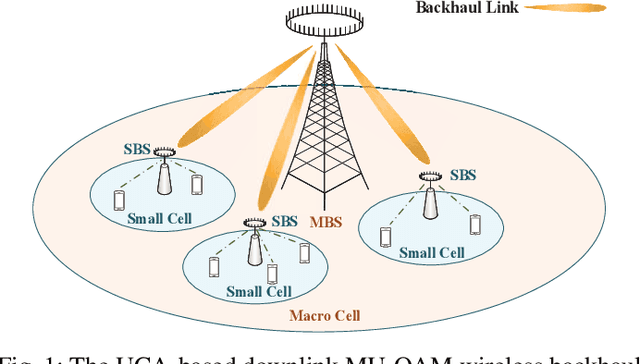

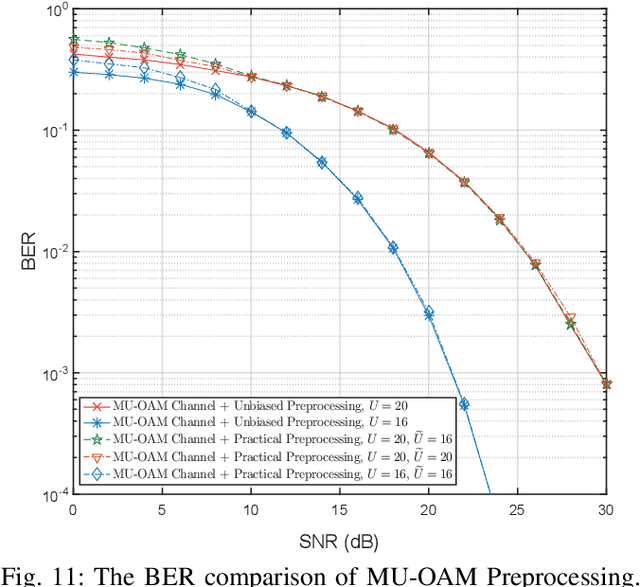
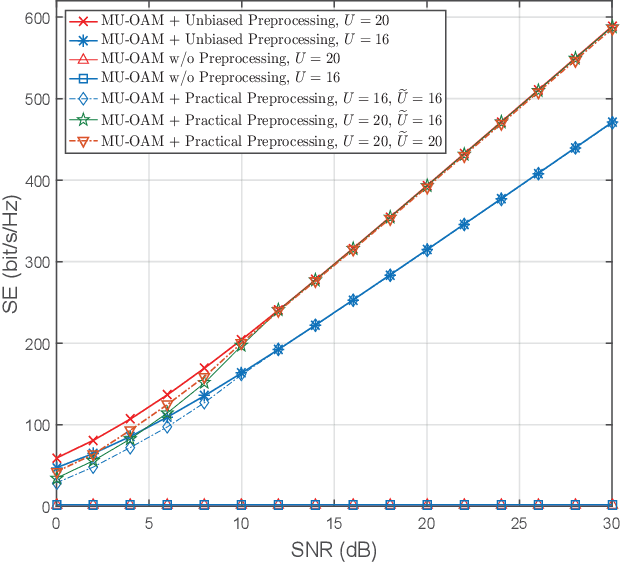
Abstract:Orbital angular momentum (OAM) at radio frequency (RF) provides a novel approach of multiplexing a set of orthogonal modes on the same frequency channel to achieve high spectral efficiencies (SEs). However, the existing research on OAM wireless communications is mainly focused on pointto-point transmission in the line-of-sight (LoS) scenario. In this paper, we propose an overall scheme of the downlink multi-user OAM (MU-OAM) wireless backhaul based on uniform circular arrays (UCAs) for broadcasting networks, which can achieve the joint spatial division and coaxial multiplexing (JSDCM). A salient feature of the proposed downlink MU-OAM wireless backhaul systems is that the channel matrices are completely characterized by the position of each small base station (SBS), independent of the numbers of subcarriers and antennas, which avoids estimating large channel matrices required by the traditional downlink multi-user multiple-input multiple-output (MU-MIMO) wireless backhaul systems. Thereafter, we propose an OAM-based multiuser distance and angle of arrival (AoA) estimation method, which is able to simultaneously estimate the positions of multiple SBSs with a flexible number of training symbols. With the estimated distances and AoAs, a MU-OAM preprocessing scheme is applied to eliminate the co-mode and inter-mode interferences in the downlink MU-OAM channel. At last, the proposed methods are extended to the downlink MU-OAM-MIMO wireless backhaul system equipped with uniform concentric circular arrays (UCCAs), for which much higher spectral efficiency (SE) and energy efficiency (EE) than traditional MU-MIMO systems can be achieved. Both mathematical analysis and simulation results validate that the proposed scheme can effectively eliminate both interferences of the practical downlink MU-OAM channel and approaches the performance of the ideal MU-OAM channel.
A Promising Technology for 6G Wireless Networks: Intelligent Reflecting Surface
Oct 18, 2021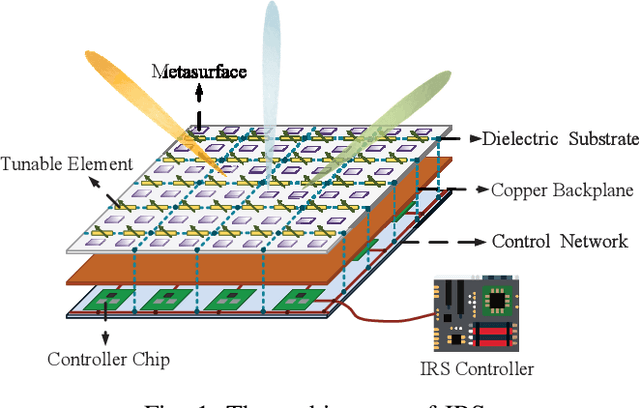
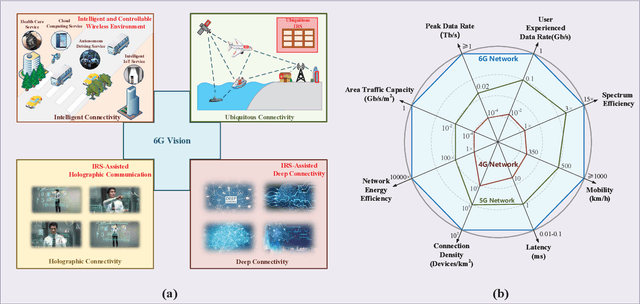

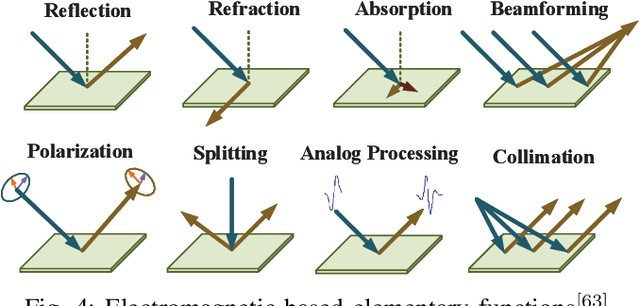
Abstract:The intelligent information society, which is highly digitized, intelligence inspired and globally data driven, will be deployed in the next decade. The next 6G wireless communication networks are the key to achieve this grand blueprint, which is expected to connect everything, provide full dimensional wireless coverage and integrate all functions to support full-vertical applications. Recent research reveals that intelligent reflecting surface (IRS) with wireless environment control capability is a promising technology for 6G networks. Specifically, IRS can intelligently control the wavefront, e.g., the phase, amplitude, frequency, and even polarization by massive tunable elements, thus achieving fine-grained 3-D passive beamforming. In this paper, we first give a blueprint of the next 6G networks including the vision, typical scenarios and key performance indicators (KPIs). Then, we provide an overview of IRS including the new signal model, hardware architecture and competitive advantages in 6G networks. Besides, we discuss the potential application of IRS in the connectivity of 6G networks in detail, including intelligent and controllable wireless environment, ubiquitous connectivity, deep connectivity and holographic connectivity. At last, we summarize the challenges of IRS application and deployment in 6G networks. As a timely review of IRS, our summary will be of interest to both researchers and practitioners engaging in IRS for 6G networks.
AoA Estimation for OAM Communication Systems With Mode-Frequency Multi-Time ESPRIT Method
Oct 18, 2021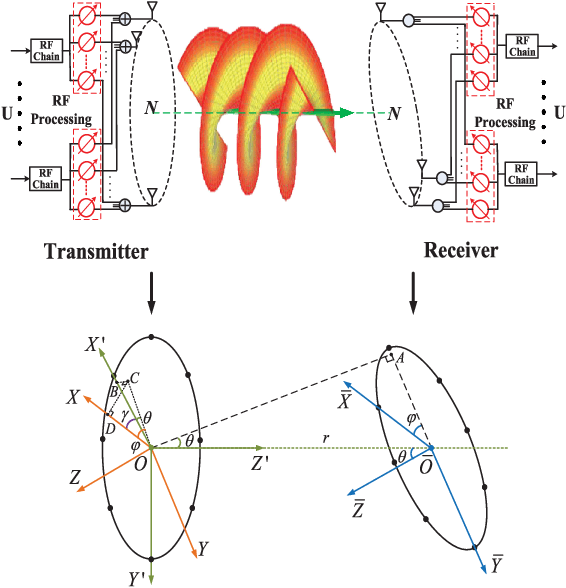

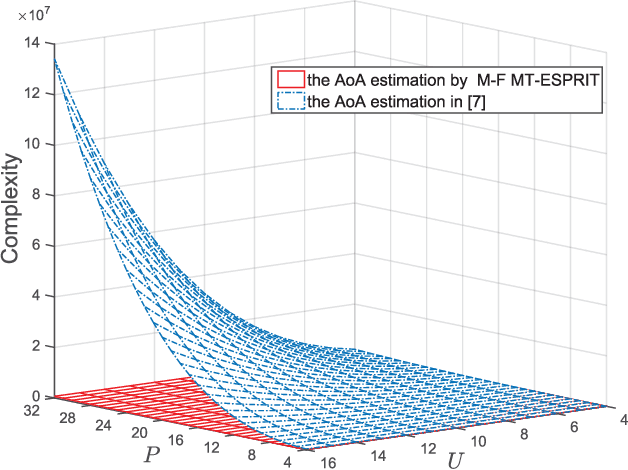
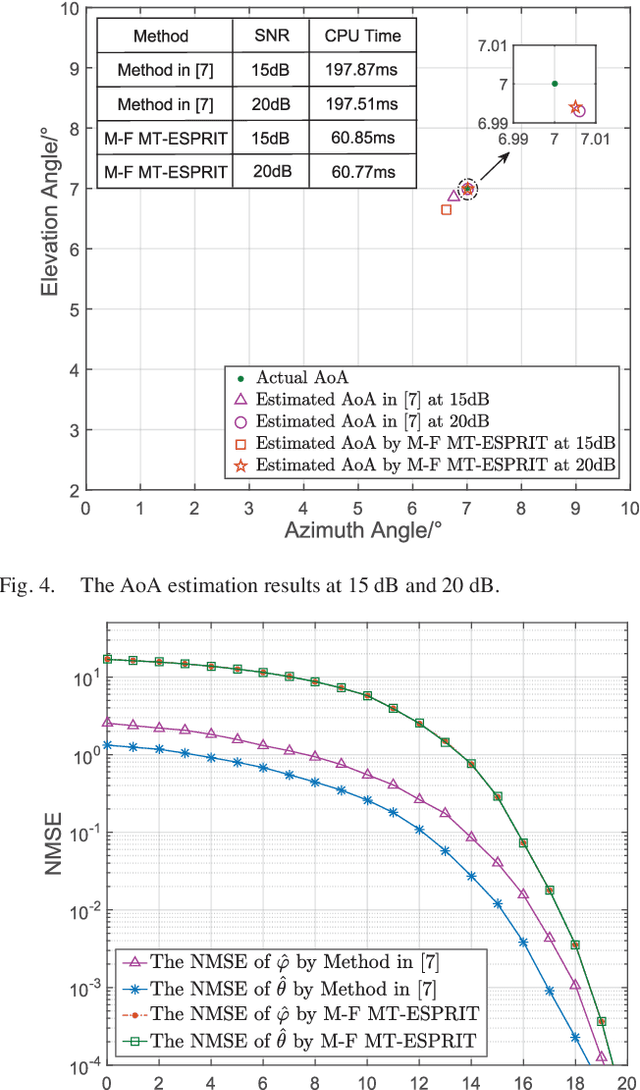
Abstract:Radio orbital angular momentum (OAM) communications require accurate alignment between the transmit and receive beam directions. Accordingly, a key feature of OAM receivers is the ability to reliably estimate the angle of arrival (AoA) of multi-mode OAM beams. Considering the limitations of existing AoA estimation techniques, in this paper, we propose an easier-to-implement AoA estimation method based on applying multiple times the estimating signal parameters via rotational invariance techniques (ESPRIT) algorithm to the received training signals in OAM mode and frequency domains, which is denoted as the mode-frequency (M-F) multi-time (MT)-ESPRIT algorithm. With this method, the misalignment error of real OAM channels can be greatly reduced and the performance approaches that of ideally aligned OAM channels.
 Add to Chrome
Add to Chrome Add to Firefox
Add to Firefox Add to Edge
Add to Edge